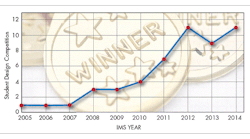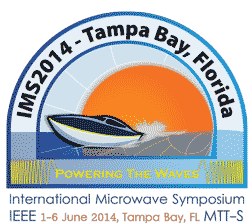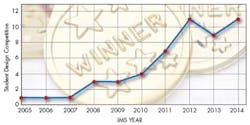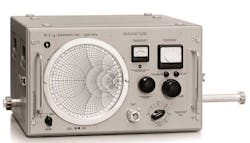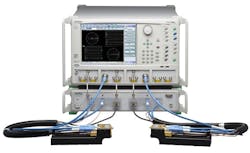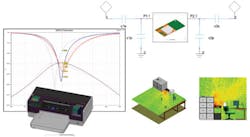This file type includes high resolution graphics and schematics when applicable.
The flagship symposium of this year’s Microwave Week, IMS 2014, will feature over 575 companies and include a schedule full with 160 technical sessions. The main fixture of the symposium is an expansive trade show, technical sessions, workshops, and panel sessions covering every aspect of the booming RF/microwave industry for both commercial and military applications.
IMS 2014 will be held at the sunny Tampa Convention Center in Tampa Bay, Fla. For all of those engineers and industry professionals who had to tough out this past winter up north, a bustling week in the Florida warmth and sun will be a great refresher. Of course, the main attraction is networking with other industry professionals on the show floor as well as at interactive forums, short courses, application seminars, and the historical exhibit.
Key Speakers & Sessions
This year marks the first time that a woman will be the plenary speaker at IMS. The honor goes to Vida Ilderem, vice president, Intel Labs director, and Integrated Computing Research (ICR) of Intel Corp. Her discussion will cover the aspects of technological innovation necessary to intelligently connect the digital and personal worlds or the “Internet of Things” (IoT). In the presentation ”How Data, Devices and Personalization are Fueling Demand for Innovation,” Ilderem will elaborate on how both academia and industry must increase the pace of innovation to continually service the latest demands and expectations of the user community. Among the host of special and focus sessions will be two memorial sessions devoted to remembering the late professors Art Oliner and Rudy Henning. In addition, a special section will highlight the microwave advancements in Latin America and the Caribbean. Microwave research efforts in Latin America also will be recognized with a showcase of current/future university and industry collaborations.
To create a dialogue around the IoT and its enabling technologies, a special session will be held as part of this year’s conference. Of particular interest are the different machine-to-machine, peer-to-peer, and peer-to-machine interactions as well as their potential applications. Interest in the IoT topic stems from the increased technological and information-based abilities of modern devices—specifically, enhanced processing power, increased context awareness, and the hope of energy independence.
Another new session this year is a pilot aimed at attracting contributions and participation from professionals working on the RF/microwave side of complex, multi-disciplinary applications and systems. The focus will be tunable antennas and system front ends. Among the concepts that will be explored are advances in cellular communications using reconfigurable front ends and tunable antennas. The discussion also will cover analog/digital interference schemes as part of innovative RF interference-mitigation techniques.
Filling out the conference will be several workshops, panel sessions, and short courses. In addition, the focus topic sessions will dive into emerging technical topics that have ignited interest in the field. Among those topics are fifth-generation (5G) wireless, terahertz circuits, silicon solutions for biomedical applications, and phase-transition microwave switches.
The lunchtime panel sessions focus on tunable RF’s ability to meet data needs, social topics with engineering education, and graphene’s material potential. For compact learning at the short courses on Sunday and Friday, experts will cover subjects including multi-technology RF design flow, near-field probe tools, nonlinear circuit device modeling, and frequency-synthesizer design techniques. On Sunday, Monday, and Friday of Microwave Week, workshops will cover aspects ranging from inkjet printing to the next generation of multi-layer fabrication and techniques for handling interference.
Student Designs & Paper Competitions
Every year, the student design and paper competitions are among the highlights of the IMS educational program. Those competitions will take place on Tuesday of Microwave Week with the student-paper finalists giving poster presentations during the sessions. The finalists include student representatives from universities in the U.S., U.K., Ireland, Taiwan, Germany, China, Israel, Sweden, Canada, Saudi Arabia, The Netherlands, and Portugal. The topics covered range from power combiners and switches to 3D circuit extraction, baluns, and RF/microwave semiconductors.
This year marks the tenth year of the student design competitions. To celebrate, 11 different competitions will take place. Each student design competition is managed by a Technical Committee (TC) of the IEEE MTT. The TCs sponsoring the competitions range from high-sensitivity radar to wireless energy harvesting with a special education feature called, “Apps for MTT.”
These apps, which target smart handheld and mobile devices, will facilitate education involving key microwave principles and phenomena. By using the advanced visual interfaces of mobile devices and their enhanced computing power, the goal is to help promote computer-aided analysis and its role in the design of microwave circuits and components. This featured competition anticipates 10 to 15 teams from universities in the U.S. and Canada.
This file type includes high resolution graphics and schematics when applicable.
MicroApps Hop Onstage
This file type includes high resolution graphics and schematics when applicable.
A series of Microwave Application Seminars or “MicroApps” will enable IMS exhibitors to give a 20-min. technical seminar on the state-of-the-art in applications, processes, and products for the microwave industry. These talks will take place at the MicroApps Theater, which is an open stage located at booth 1246. It will provide the forum for interested attendees to stop by while perusing exhibitor booths. A schedule for the MicroApps Theater is provided on the IMS 2014 website. The talks will take place from early morning Tuesday to mid-afternoon Thursday.
Co-Located Conferences
Microwave Week is jam-packed with conferences and symposiums that cover every aspect of the microwave industry. The IEEE Radio Frequency Circuit Symposium, Automatic RF Techniques Group (ARFTG), IMS, and the Microwave Technology Conference (WAMICON) will all be co-located at the Tampa Convention Center. RFIC goes from June 1 to 3. It is followed by the IMS Conference from June 3 to 5. Wrapping up the week, ARFTG and WAMICON are simultaneously staged on June 6th.
The RFIC symposium focuses on the academic and industrial technical accomplishments of integrated RF circuits, devices, and systems. Applications featured at RFIC include high-speed data transceivers, millimeter-wave systems-on-a-chip (SoCs), and wireless mobile ICs. Kicking off the symposium on Sunday will be workshops, an evening of plenary talks/roundtables, and a late evening reception. The Monday and Tuesday sessions offer presentations of contributed papers and lunchtime panels. They end with an interactive forum.
After RFIC and IMS conclude, ARFTG and WAMICON launch to provide an enhanced focus for the microwave community. ARFTG is an in-depth technical organization geared toward the RF/microwave test and measurement community. The conference encourages peer interaction between experts in test and measurement technology, who can collaborate on the latest industry challenges. In recent years, the ARFTG conference has expanded its offerings as the industry’s interests have grown. It now encompasses computer-aided design (CAD), metrology measurement, connector repeatability, nonlinear measurements, multi-port network analysis, and many other cutting-edge aspects of the field. In addition, the conference features a microwave measurement conference, measurement short course, and a free service for S-parameter measurement comparisons among different laboratories.
In response to the advanced multidisciplinary and interdisciplinary R&D aspects of RF/microwave wireless technology, WAMICON 2014 promises to address the latest cross-discipline challenges. This year, emerging RF/microwave technologies and wireless communications will be the main focuses. Researchers working with emerging technologies in the fields of biomedical applications, wireless sensing, energy harvesting, wireless power transfer, terahertz technologies, nano-devices, and circuits are specifically encouraged to contribute. For its part, the wireless-communications portions will spotlight developers on the bleeding edge in cognitive radio, advanced data networks, ultrawideband, multiple input multiple output (MIMO), multicarrier approaches, spread spectrum, channel characterization/modeling, and software-defined radios.
Taking A Peak With Test And Measurement
At IMS, the main attractions outside of the conference are the cutting-edge technology products showcased on the exhibition floor. Almost 600 companies from all over the globe will be featuring their latest products at this year’s show, including test and measurement equipment, design/simulation software, components, devices, and semiconductor products to meet every demand in the field.
The test and measurement industry, for example, will welcome a wealth of new releases and testing capabilities from companies like Aeroflex, Agilent, Anritsu, National Instruments, and Rohde & Schwarz. The new TM500 LTE-A Test Mobile and E500 Capacity Test System from Aeroflex, for example, support the aggregation of three component carriers (3 CC). Carrier aggregation of 3 CC allows mobile network operators to achieve data rates to 450 Mbit/s on their LTE-A networks. “The TM500 Test Mobile is the first commercial infrastructure test platform to offer 3 CC,” says Shusina Ngwa, product manager at Aeroflex. “Offering this capability at such an early stage is crucial to enable network performance to be tested and validated ahead of the availability of end-user terminals and handsets.”
Agilent Technologies is expected to be putting forth a lot of effort into rebranding its Electronic Measurement Group as Keysight Technologies. In terms of products, the firm is expanding its lower-profile product offerings by introducing the M9393A. This 27-GHz, PXIe vector signal analyzer delivers microwave measurement technology in a PXI form factor. It is suited to the manufacturing and design validation of transmitters and components for radar, military, satellite, and commercial wireless communications. Also on hand at the show will be Agilent’s’ FieldFox Handheld Analyzers, which have received an upgrade for radar installation and maintenance (I&M). As a result, the firm claims there is finally a viable alternative to expensive, lab-grade instruments that make time-consuming measurements.
To serve a wider audience, Anritsu is releasing a 70-kHz-to-145-GHz broadband vector network analyzer (VNA) system with a single-coax connection. Called the VectorStar ME7838D, it promises to give design engineers greater confidence when performing on-wafer device characterization at 70 GHz and beyond. By conducting a single sweep on a device over multiple RF, microwave, and millimeter-wave waveguide bands, it claims to enable engineers to more accurately characterize devices. As a result, engineers can create more accurate models and enjoy fewer design turns when devices are used in applications. Sample applications include 77-GHz car radar, E-band wireless communications, 94-GHz remote sensing and airport radar, and emerging applications beyond 110 GHz.
National Instruments will be showcasing capabilities ranging from power-amplifier (PA) design through test. A wide range of PA technologies will be demonstrated including envelope tracking and digital predistortion. The booth will feature solutions from AWR’s software environment as well as NI’s PXI measurement technology. Much of the attendee attention will likely go to the USRP RIO 2×2 MIMO software-defined radio (SDR), which will make its debut at the show. According to Farris Alhorr, SDR product manager at National Instruments, “Together, the NI LabVIEW software and NI USRP RIO compose an ideal platform for rapidly prototyping high-performance, multichannel wireless-communication systems like the 5G massive MIMO testbed being developed by Lund University in Sweden."
Attendees also should be sure to stop by the Rohde & Schwarz booth. It will be demonstrating how test and measurement instruments have evolved—from the world’s first vector network analyzer, which was introduced in 1950, to the new, at-this-point unannounced product launches slated for IMS. The firm also will offer demonstrations of group delay, envelope tracking, PA measurements, and other radar, satellite, and transmit-receive measurement setups.
This file type includes high resolution graphics and schematics when applicable.
Getting Virtual With Design And Simulation Software
This file type includes high resolution graphics and schematics when applicable.
In addition to its test and measurement releases, Agilent Technologies is announcing two software updates. Advanced Design System 2014 promises to improve design productivity and efficiency with new technologies and capabilities. With its 2014.05 release, for example, Genesys now tackles digitally modulated RF signals for circuit and system designs. Using Genesys 2014, the digitally modulated RF signals found in today’s consumer and defense wireless applications can supposedly be simulated in circuits and systems as easily as traditional analog RF signals can be simulated. Genesys 2014 also delivers system budget analysis of error-vector magnitude, bit-error rate, or adjacent-channel-power-ratio (ACPR) digital-modulation metrics for every component in the system block diagram. As a result, RF designers can identify any components causing digital performance failures.
Enhancements also can be seen in HFSS from ANSYS, which now includes linear circuit simulation as well as the RF and signal-integrity (SI) option packages. According to the company, these new features help users quickly identify potential design problems with increased flexibility. They also provide easier access to a complete set of analysis capabilities that can be leveraged throughout a high-frequency electromagnetic (EM) simulation flow.
With the addition of linear circuit analysis, HFSS allows engineers to design, simulate, and validate antennas, microwave components, and RF/microwave circuits. It also vows to tackle the challenges of antenna integration and system EMI on mobile devices. By adding the ANSYS RF option to HFSS, designers gain an RF simulation flow that offers the following: harmonic-balance circuit simulation for nonlinear microwave-circuit amplifier analysis; a 2.5D Method of Moments solver integrated in the HFSS 3D layout interface; and filter synthesis. This flow includes DC, transient, oscillator, load-pull, and envelope-circuit analysis engines.
When HFSS is combined with the new ANSYS SI Option, the company claims that it is possible to analyze the signal-integrity, power-integrity, and EMI issues caused by shrinking timing and noise margins in PCBs, electronic packages, connectors, and other complex electronic interconnects. The SI option was created to help HFSS handle the complexity of modern interconnect design from die to die across ICs, packages, connectors, and PCBs. As is always the goal with such software, the objective is for engineers to be able to understand the performance of high-speed electronic products long before building a prototype in hardware. According to Matt Commens, product manager at ANSYS, “It’s becoming increasingly important for our customers to be able to quickly analyze their full electromagnetic system and to be able to include in their simulations both circuit-level components and the highly accurate models simulated by HFSS.
For its part, AWR Corp.—a National Instruments Company—is highlighting release V11 of its NI AWR Design Environment. With this release, the Analyst 3D front-end-module (FEM) EM simulator introduces new antenna measurement capabilities as well as a ready-built 3D parts library of microwave connectors, coils, packages, antennas, and more. It also provides user-configurable 3D PCells for custom-parts library creation. According to Sherry Hess, VP marketing at AWR, “AWR’s V11 release of the NI AWR Design Environment emphasizes our commitment to enabling our customers to spend more time focused on their design challenges and less time on driving the software. The Analyst ready-built 3D parts library is a prime example of this commitment.”
At the CST booth, the focus will be on the release of the 2014 version of the EM simulation tool, CST Studio Suite. This edition promises to raise solver performance while increasing hybrid simulation capabilities without compromising usability. Improving meshing also was a major focus during this release’s development. Both the hexahedral and tetrahedral mesh have been enhanced to reduce cell count and help to discretize complex or low-quality CAD data. The simulation of complex systems also has been improved.
In addition, field-source coupling and multiphysics simulations can be set up automatically using the new System Assembly and Modeling (SAM) wizards. SAM allows different solvers to be combined in a single simulation project. Alternatively, it can be used to model complex systems one component at a time. CST software also plays a role in the new offering from Delcross Technologies, Savant Version 4.0. Savant is a high-frequency electromagnetic (EM) software aimed at analyzing the performance of antennas when they are installed on electrically large vehicles and platforms. In Savant Version 4, Delcross has teamed with CST to provide integration between the full-wave 3D EM solvers in CST Microwave Studio 2014 and the asymptotic EM solver in Savant V4. As a result, antenna designers can model and optimize an isolated antenna in CST MWS. They can then use the full-wave result in Savant to efficiently analyze the antenna’s performance when mounted on a vehicle, which may be thousands of wavelengths in size.
In addition, Delcross has added a uniform theory of diffraction (UTD) edge-diffraction ray capability to the Savant solver. It enhances the far-field analysis accuracy in directions that are shaded from direct illumination by the antenna. Multiple, complex platform CAD models also can be imported into Savant V4 or combined into subassemblies, which may be independently rotated or translated.
Another software partnership can be seen in Sonnet Software’s Blink. This multi-solver passive-device modeling suite operates entirely from within the Cadence Virtuoso environment. The multi-solver uses Sonnet’s traditional shielded Method of Moments (MoM) solver as well as a new fast solver. The new solver uses advanced algorithms to accelerate the device modeling process. As a result, the company claims that users can quickly characterize spiral inductors, baluns, transformers, MIM capacitors, interdigitated capacitors, and transmission lines for RF-integrated-circuit (RFIC) and mixed-signal-IC design.
Both solvers also operate with PDK-specific stackups, which can be customized for a specific implementation.
This file type includes high resolution graphics and schematics when applicable.
Hanging Out With Devices And Subsystems
This file type includes high resolution graphics and schematics when applicable.
Beyond test and measurement and software, the exhibition floor always offers impressive systems and subsystems that serve military as well as commercial needs. API Technologies, for example, is highlighting a line of standard switched-filter banks. Offering customer-defined passband frequencies from 20 to 7500 MHz with ultimate rejection to 20 GHz, these switched-filter banks also boast rugged construction. This feature makes them well suited to military and high-end commercial applications that require superior signal integrity, such as electronic warfare (EW) and electronic intelligence (ELINT).
These devices use mechanically channelized, PIN-diode switch manifolds for lower insertion loss and high isolation while lumped-element filters help to increase rejection. They also feature integrated switch drivers with typical switching speeds of 200 ns. Melissa Fisher, API’s director, Marketing and Communications, shares, “API Technologies is pleased to showcase our new line of 2-to-7-channel, switched-filter banks at IMS. We pride ourselves on providing our customers with the high level of performance that is required in the configurations that they want.”
Meanwhile, Cobham will be showcasing a dual-polar UHF sector antenna for use in the white-space frequency bands. These first-generation products will be available in 2-, 3-, and 5-GHz bands. The wideband SA11-90-0.6VH/2178 antenna provides both vertical and horizontal polarizations. In conjunction with radios and with two-port diversity, it can provide non-line-of-sight (NLOS) connectivity and reliable communications in challenging environmental conditions.
The SA11-90-0.6VH/2178 antenna covers 470 to 700 MHz. Notably, the antenna can be used in situations where a number of channels are spaced widely apart. Having peak gain of 11 dBi, a 90-deg. beamwidth, the SA11-90-0.6VH/2178 antenna can be used alone to provide sector coverage. Four units are required to achieve 360-deg. coverage. With appropriate power dividers and phase-matched cables, several antennas also could be stacked vertically—producing a narrower-elevation beam width and increased gain. Cobham has integrated both sets of the polarized elements within the same vertical aperture, producing a lightweight, rugged antenna measuring 1550 × 550 × 232 mm and and weighing approximately 20 kg including the mounting kit.
At the Empower RF booth, attendees can see live demonstrations of the firm’s 1-kW and 500-W high-power amplifiers. The new PAs come in reduced chassis sizes: 5U for the 1-kW unit and 3U for the 500-W unit. For its latest PA systems, the firm also is offering software for the real-time reporting of PA diagnostics as well as remote monitoring/control. Because the latest PA modules are packaged as building blocks, they can be combined to scale for different applications.
The most recent debut from JFW is an RF low-passive-intermodulation (low-PIM) attenuator. The 50FLP-XXX-100 fixed attenuator boasts a maximum PIM reading of -155 dBc (-165 dBc typical). It covers 698 to 2700 MHz and is available in values of 5, 6, 10, 20, and 30 dB. The 50FLP series handles average RF power to 100 W while maintaining accuracy of ±0.75 dB and a typical voltage standing wave ratio (VSWR) of 1.3:1. According to the firm, it expects this attenuator line to impact the LTE/DAS and cellular test markets, where there has been a lack of competition for several years.
At the Lake Shore Cryotronics booth, the company will be showing a 7-in. magnet version of its AC/DC Hall measurement system as well as an integrated system for terahertz materials characterization. The Model 8407 Hall effect measurement system features a 7-in. magnet for measuring mobilities at the low end of the DC-field measurement range (from 1 to 106 cm2/V s). With the AC-field measurement added, the system is capable of measuring materials with extremely low mobilities (down to 10-3/V s). Examples include photovoltaic (solar cell), thermoelectric, and organic electronic materials, which have electronic properties that can be difficult to measure with DC-field Hall methods.
The firm’s 8500 Series terahertz system is a fully integrated hardware/software platform for the characterization of electronic, magnetic, and chemical materials. The system uses non-contact, terahertz-frequency energy and an integrated low-temperature, high-field cryostat to measure material spectroscopic responses across a wide range of frequencies, temperatures, and field strengths. The system performs continuous-wave spectroscopic response measurements to derive key material properties, such as dielectric constant, dynamic conductivity, carrier scattering times and mobilities, vibrational resonances, and magnetic resonances.
Marki Microwave will display a host of mixers and other RF/microwave parts including the 300-kHz-to-36-GHz isolation balun. That balun provides conversions between balanced and unbalanced signals—primarily for device and system testing. It flaunts ±0.5 dB amplitude and ±3-deg. phase balance across the entire operating band. In addition, the two output ports are isolated from each other, making it insensitive to balanced-port termination and crosstalk between balanced ports. This new device nearly doubles the frequency range of available instrumentation baluns without increasing the low-end cutoff, which is so important for baseband data. In other words, it can operate with up to 40 Gb/s data streams. Additionally, its isolation makes it usable to extend a two port VNA to differential testing capabilities without additional attenuation.
At the TMD booth, a full set of power modules, amplifiers, power supplies, and fast-warm traveling wave tubs (TWTs) will be on display. The new solid-state microwave power module, PTS6900, covers 2 to 6 GHz while putting out 150 W. Leveraging the latest 0.25-µm GaN MMIC technology and low-loss power combiners, it is optimized for EW/ECM systems.
Vectron International will be spotlighting a microelectromechanical-systems (MEMS) product, which incorporates a single-crystal silicon resonator that is Epi-sealed in a vacuum. The resonator is 1/3000th the mass of a comparable quartz resonator. Due to its size, it boasts high shock tolerance and low aging, making the device well suited for military munitions and harsh environmental applications. Vectron’s HT-MM900A Military Temperature MEMS oscillator can operate as a reference clock for demanding applications while withstanding shock of 30,000g, providing vibration resistance of 70g, and offering g-sensitivity of 0.1 ppb/g.
In addition, this MEMS oscillator can scale to smaller footprints and function with different supply voltages while operating from -55° to 125°C with a low-g-sensitivity, 5-×-7-mm temperature-compensated crystal oscillator (TCXO). The TX-707 TCXO boasts g-sensitivity beyond 0.2 ppb/g standard with a 0.1-ppb/g option. It maintains ±1 ppm stability from -40° to +85°C.
This file type includes high resolution graphics and schematics when applicable.
Keeping It Reel With Components And Semiconductors
This file type includes high resolution graphics and schematics when applicable.
Of course, the exhibition floor at IMS will be once again be teeming with large numbers of components and component makers. Targeting the high-Q requirements of modern filters, for instance, BSC will be showcasing its high-K-material filters in a small footprint. Using thin-film techniques lends this production process high levels of precision and repeatability. Operating from -55° to +125°C, these filters serve applications encompassing L-band to millimeter frequencies with varying topologies of diplexers and filters—bandpass, notch, low-pass, high-pass, and roofing. Solutions can be produced in open tile for direct die-level integration or packaged footprints for solder reflow.
Coaxicom will be featuring its phase-adjustable connector, which is now offered with a direct solder solution for RG402, 0.141 semi-rigid and ultra-flex cables. According to the firm, the connector allows for precise manual adjustments to phase without signal degradation over frequency ranges to 18 GHz. The 3993-2 RF connector has an adjustment range of 180 deg. minimum and a maximum VSWR of 1.30:1 with insertion loss 0.42 dB.
Highlights for Coilcraft include the compact PFD3215 series coupled chip power inductor. The dual-wound PFD3215 features a 1:1 turn ratio. Itis designed for use in a variety of circuits including flyback, multi-output buck, and SEPIC. These versatile inductors also can be used as two single inductors connected in series or parallel, as a wideband transformer, or as a common-mode choke. Measuring 3.2 × 2.3 × 1.5 mm, they are a good choice when board space is limited and a low profile is desired. Typical applications include tablets and other battery-operated mobile devices requiring precise voltage regulation, efficient charging, and maximum operating time. Also included in the Coilcraft showcase will be the new 1111SQ series of high-performance, square air-core inductors offer high Q factors (up to 200 at 400 MHz) and inductance values from 27 to 47 nH.
New from MACOM is the ceramic GaN-on-SiC HEMT power transistors and GaN-in-plastic-packaged power transistors. The gold-metallized GaN-on-SiC MAGX-001090-600L00 and MAGX-000912-500L00 are optimized for pulsed avionics applications, such as secondary surveillance radar in air-traffic-control systems. They put out 600 W or 500 W of power with typical gain of 21.4 dB or 19.8 dB and 63% or 60% efficiency. The MAGX-001090-600L00 also offers low thermal resistance of 0.05°C/W and load mismatch tolerance of 5:1. In addition, it can be used effectively under more demanding Mode-S ELM operating conditions, thanks to its low pulse drop of 0.2 dB. Paul Beasly, product manager of MACOM, comments, “These devices are an ideal candidate for customers looking to upgrade avionics systems, which require increased functionality and flexibility without sacrificing power, efficiency, or size.”
From the student paper competition to a hospitality suite, transportation, and refreshments, Mini-Circuits is a very active IMS sponsor this year. At its booth, the firm will be highlighting a wide array of products including a programmable attenuator, RF switches, and a microwave amplifier. The RCDAT-6000-90 attenuator, for example, is either USB or Ethernet controlled with attenuation to 90 dB. With a step size of 0.25 dB, it can be switched at a rate of 650 ns while covering 1 MHz to 6 GHz. Leading the firm’s switch line is the JFW series of single-pull double-throw (SPDT) and single-pull six-throw (SP6T) RF switches. These switches have a single positive supply voltage with a medium power requirement to 35 dBmover a range of 10 MHz to 6 GHz.
Also on hand at Mini-Circuits will be the AVM-273HP+ three-stage balanced, wideband monolithic amplifier delivering power to 0.5 W. Operating from 13.0 to 26.5 GHz, it is designed using PHEMT technology and is unconditionally stable. The amplifier’s isolation enables it to be used as a wideband isolation amplifier or buffer amplifier in a variety of microwave systems including point-to-point radios, military EW and radar, Dr oppler beam sharpening, and VSAT.
Peregrine Semiconductor is debuting power limiters that it claims may replace GaAs-based PIN diodes. These 50-W UltraCMOS RF power limiters are the PE45140 (20 MHz to 2 GHz) and PE45450 (9 kHz to 6 GHz). By providing a monolithic alternative to discrete, PIN-diode limiters, they promise to serve test-and-measurement, land-mobile-radio, wireless-infrastructure, military, and radar systems. On a chip that is 8× smaller than the board space required by discrete, PIN-diode solutions, Peregrine claims that its new power limiters provide a 10× to 100× improvement in response and recovery time. In addition, they supposedly deliver an improvement in linearity (IP3) greater than 40 dB while offering a 20× improvement in electrostatic-discharge (ESD) protection. “Poised to replace GaAs-based PIN diodes, our new UltraCMOS RF power limiters will prove to be another example of UltraCMOS technology displacing GaAs in the marketplace,” says Duncan Pilgrim, Peregrine’s VP of marketing.
Among other components being highlighted at this year’s show will be the higher-frequency band-reject and cavity-comb line/interdigital bandpass filters from RLC Electronics. RLC’s notch filters, which cover 0.01 to 28 GHz, are characterized by having the reverse properties of bandpass filters.They boast typical insertion loss under 1.0 dB with VSWR below 1.5:1. For their part, the fixed-tuned bandpass filters are centered in the Ka band (26.5 to 40.0 GHz). They provide rejection carrying to 50 GHz. Both filter types are constructed to operate over the most severe military environmental conditions.
Taking pride in its latest low-noise amplifiers (LNAs), Skyworks Inc. is featuring the SKY67150-396LF (300 to 2200 MHz) and SKY67153-396LF (700 to 3800 MHz) GaAs LNAs. The devices use Skyworks’ pseudomorphic high-electron-mobility-transistor (HEMT) enhancement-mode process in a compact 2-×-2-mm, 8-pin, dual flat no-lead package. The internal active-bias circuitry vows to provide stable performance over temperature and process variations. These LNAs also can externally adjust supply current.
Proof of the recent joining of RFMD and TriQuint can be seen in the joint design and sales support for a 5-GHz, IEEE 802.11a/n/ac-compliant wireless-local-area-network (WLAN) FEM from TriQuint. The TQP8080 combines an LNA with bypass mode and a PA with an integrated power detector through an SPDT transmit/receive (T/R) switch. The internally matched input and output work to ease design together with the CMOS-compatible control voltages. According to John Hamilton, director of Marketing of RFMW, “With all of the competition for front-end modules, TriQuint has raised the bar with their TPQ8080 WLAN FEM. The inclusion of a power detector for the 5-GHz PA, bypass mode for the LNA, and an SPDT switch is an 802.11ac FEM integrator’s dream come true.”
This file type includes high resolution graphics and schematics when applicable.
